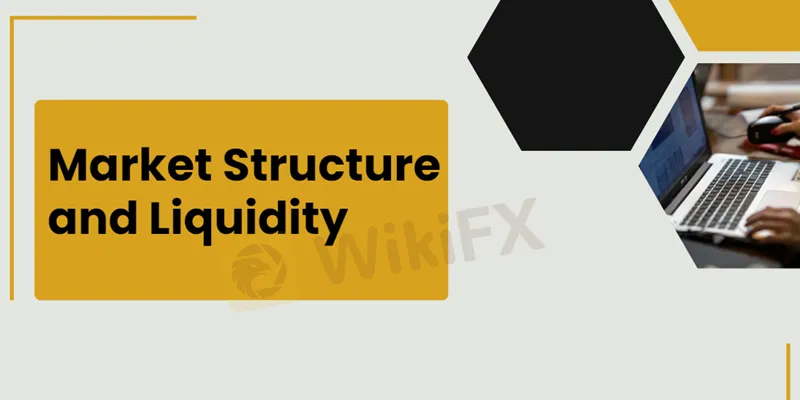Abstract:The variation in prices for the same currency pair among different brokers can often cause confusion, particularly for novice forex traders.

In this article, we will delve into the underlying factors that contribute to these discrepancies and shed light on why different forex brokers offer different prices. By understanding the reasons behind these variations, traders can gain clarity and make more informed decisions when navigating the forex market.
Market Structure and Liquidity
Understanding market structure and liquidity is important for forex traders as it helps them navigate the market effectively. Different brokers may have varying access to liquidity providers and employ different trading models, which can result in differences in prices and execution quality.
Market Structure
The forex market has evolved from a centralized structure to a more decentralized and fragmented one. Traditionally, the market operated through dealer-customer relationships, where banks acted as the primary liquidity providers.
However, with advancements in technology and the rise of non-bank financial institutions, the market structure has become more diverse. Aggregator platforms now connect traders with various liquidity providers, allowing for a wider range of counterparties and trading venues.
This fragmented market structure has both advantages and disadvantages. On the positive side, it has increased trading velocity and reduced search costs by connecting more participants. However, it can also raise concerns about market efficiency, such as increased search costs and adverse selection problems. To address these concerns, innovations like liquidity aggregation have emerged, linking different liquidity pools and allowing participants to choose preferred counterparties and receive competitive price quotes.

Liquidity
Liquidity, on the other hand, refers to the ease with which market participants can buy or sell a financial instrument without causing significant price movements. In the forex market, liquidity is crucial because it ensures that traders can enter and exit positions at desired prices. High liquidity leads to tighter bid-ask spreads and lower transaction costs, while low liquidity can result in wider spreads and slippage.
Liquidity in the forex market is influenced by various factors, including the number and activity of market participants, the depth of the order book, and the availability of liquidity providers. Liquidity providers, such as banks and non-bank financial institutions, play a vital role in supplying liquidity to the market. Clients access this liquidity through different channels, including trading platforms and electronic communication networks (ECNs).
Broker Business Models
Forex brokers employ diverse business models to effectively manage risk, generate revenue, and meet the unique requirements of their clients. Understanding these varying models is crucial for traders operating in the forex market. Let's explore some of the common business models adopted by forex brokers:

A-Book Model: In the A-Book model, brokers act as intermediaries, facilitating clients' trades directly in the market. They earn revenue through spreads, commissions, or a combination of both. This transparent model ensures brokers have no conflict of interest with their clients' trades. However, relying solely on spreads and commissions for profitability can present challenges for brokers.
B-Book Model: The B-Book model involves brokers taking the opposite side of their clients' trades, essentially becoming the counterparty. Rather than passing trades to the market, brokers manage the associated risk internally. This model can be more profitable for brokers as they can capitalize on clients' losses. However, concerns arise regarding potential conflicts of interest, as brokers may have an incentive to manipulate prices or trade against their clients.
Hybrid Model: The hybrid model combines elements from both the A-Book and B-Book models. Brokers employing this model selectively pass some trades to the market (A-Book) while assuming the opposite side of other trades (B-Book). This approach enables brokers to effectively manage risk and cater to different client types. However, transparency and the potential for conflicts of interest remain valid concerns, contingent upon the implementation of the hybrid model.
Broker-Specific Agreements
When engaging in forex trading, traders often come across specific agreements when collaborating with a forex broker. These agreements serve to establish the terms and conditions governing the trading relationship between the trader and the broker. While the exact agreements may differ across brokers, there are several common forex broker-specific agreements to consider:

Leverage Agreement: A leverage agreement is a contractual arrangement between traders and brokers that enables traders to trade with leverage. Leverage allows traders to control larger market positions with a smaller amount of capital. This agreement outlines the terms and conditions pertaining to margin trading, including margin requirements, leverage ratios, and the associated risks.
Account Agreement: An account agreement is a contract that delineates the terms and conditions governing a trader's account with a broker. It covers various aspects such as account opening procedures, policies for account funding and withdrawals, trading fees and commissions, order execution protocols, and other pertinent information related to the account. Thoroughly understanding the account agreement is crucial before initiating an account with a broker.
Risk Disclosure Statement: A risk disclosure statement is a document furnished by brokers to bring attention to the potential risks associated with forex trading. It educates traders about the inherent risks, encompassing market volatility, leverage risks, liquidity risks, and other factors that can influence trading outcomes. Generally, traders must acknowledge and accept the risks outlined in the risk disclosure statement before engaging in forex trading.
Customer Agreement: A customer agreement is a legal document that establishes the rights and obligations of both traders and brokers. It covers various facets such as account maintenance, trading terms, dispute resolution procedures, and other significant contractual terms. The customer agreement aims to safeguard the interests of both parties and ensure a transparent and equitable trading environment.
Privacy Policy: A privacy policy delineates how brokers collect, utilize, and safeguard the personal and financial information of their clients. It elucidates the measures taken to protect client data and specifies the circumstances under which client information may be shared with third parties. Traders should carefully review the privacy policy to comprehend how their information will be handled by the broker.
Market Conditions and Volatility
The forex market is known for its dynamic nature, and market conditions and volatility play a crucial role in shaping trading opportunities. Volatility refers to the frequency and magnitude of price movements in the market. In the context of the forex market, volatility represents the extent to which currency exchange rates fluctuate. Higher volatility implies larger and more frequent price swings, while lower volatility suggests more stable and predictable price movements.

Several factors can contribute to changes in forex market volatility. These factors include economic indicators, geopolitical events, central bank policies, interest rate changes, market sentiment, and unexpected news releases. For example, major economic announcements like GDP reports, employment data, and central bank decisions can significantly impact market volatility.
Market conditions and liquidity are closely related to volatility. Liquidity refers to the ease with which an asset can be bought or sold without causing significant price changes. In forex, liquidity is influenced by the participation of market participants, such as banks, financial institutions, and individual traders. During periods of high volatility, market liquidity can decrease, leading to wider bid-ask spreads and potentially slippage in trade execution. It is important for traders to be aware of market conditions and adjust their trading strategies accordingly .
Broker Technology and Infrastructure
The technology and infrastructure used by forex brokers play a crucial role in their ability to provide efficient and reliable trading services to their clients.
Forex brokers often rely on data centers and colocation services to ensure fast and secure connectivity to the global financial markets. Companies like Equinix provide data center and colocation services to facilitate reliable and low-latency trading.
The trading platform is a critical component of a forex broker's infrastructure. It is the primary tool that traders use to execute trades, monitor market data, and manage their accounts. Forex brokers may use third-party trading platforms or develop their own custom platforms. These platforms should be stable, reliable, and user-friendly, with features that cater to the diverse needs of traders.

Forex brokers strive to provide fast execution speeds and access to deep liquidity pools. Some brokers, like Titan FX, leverage advanced technology to offer unparalleled execution speeds, liquidity, and pricing.
High-frequency trading firms utilize sophisticated technology and infrastructure to execute trades at extremely high speeds. These firms often employ algorithmic trading strategies and leverage low-latency infrastructure to gain a competitive edge in the market.
Forex brokers may provide APIs and developer tools to enable third-party developers to build applications and integrate with their trading systems. Alpaca, for example, offers a developer-first API for trading, allowing developers to build trading applications easily.
Conclusion
Overall, the variation in prices among forex brokers is a combination of factors such as liquidity providers, fee structures, technological capabilities, and market conditions. Traders should consider these factors when selecting a broker and be aware of the potential impact on their trading costs and execution quality.















